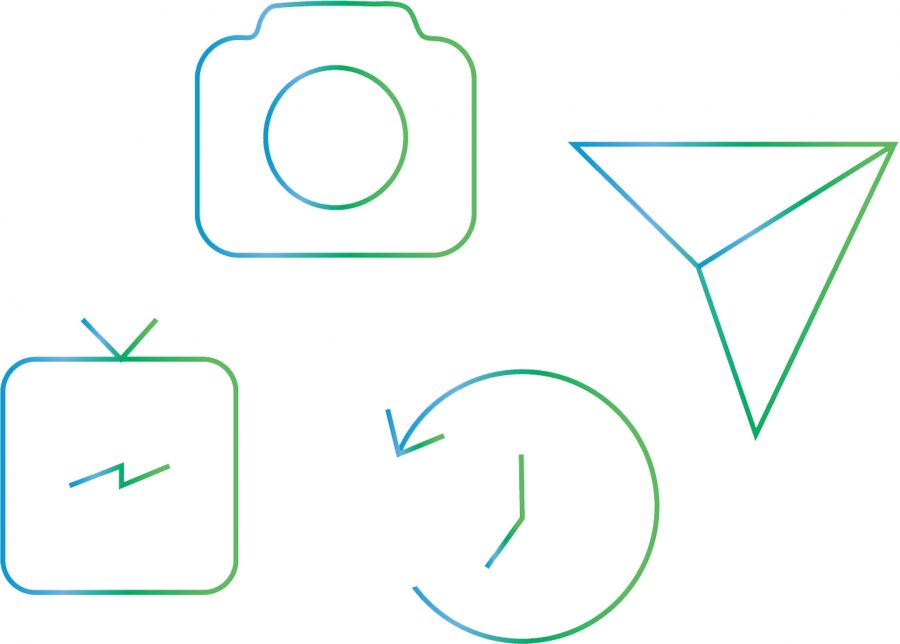From the rise and fall of internet sensations on platforms such as YouTube and TikTok to “Netflix and Chill,” the world has been remarkably altered in the 21st century by the Internet, Google and technology like Alexa. Adding to a growing list, the sweeping phenomenon of the century: phones. Children as young as 6, according to CNN, now have unlimited access to nearly everything at the click of a button, unheard of 35 years ago.
Addiction, distracted driving and anxiety include some of the costs of smartphones, according to Psychology Today. A fact that has mostly affected teenagers as more than 88 percent, ages 13 to 17, now have access to a mobile device.
A 2015 survey published by Common Sense Media, a non-profit organization that aims to promote safe technology and media for children, found American teenagers ages 13 to 18 spend six and a half hours of screen time per day on social media and other online activities. Teens do realize the extent to which they are using their cell phones, according to Engadget, a technology blog network with coverage of consumer electronics, nearly 54 percent ages 13 to 17. Senior RJ Baguio said he checks his phone more than 50 times a day.
“Whenever I see a notification I usually just open it or, I don’t know, I usually just get on it,” Baguio said. “It’s like a habit.”
Looking for notifications that aren’t there, constantly itching to check social media feeds and responding to text messages within seconds is an addiction. To classify a condition as an “addiction,” professionals have to analyze the causes and effects of the issue, according to Psychology Today. Dopamine, a chemical produced by one’s brain, plays a role in motivating behaviors such as those influenced by feelings of pleasure and satisfaction. When someone receives a notification or a text message, dopamine is released throughout the body. Every vibration alerting someone of an incoming notification has the potential to be a “positive social stimulus and dopamine influx,” according to the Harvard Business Review.
This addiction is so prevalent in today’s world that a term, first discovered in 2008, is used to describe those suffering from it. Nomophobia, or “no-more-phone phobia,” is the irrational fear of being without a phone or being unable to use it. One in five people in the United States would rather go without shoes for a week than take a break from their phone, according to Psychology Today.
Not only are teens staying up late to finish homework or continuing to procrastinate studying, but they are also unable to go to sleep without their cell phones nearby, which can cause sleep deprivation. From 2009 to 2015, the number of U.S. teens who reported sleeping less than seven hours a night was 16-17 percent more likely, according to PBS NewsHour, a fact junior Peyton Brooks is aware of as she stays up late into the night wanting to “finish an episode on Netflix.”
Experts in sleep research agree that teens, ages 14 to 17, need at least nine hours of sleep a night in order to fuel a developing mind and body. By 2015, however, 43 percent of teens reported sleeping fewer than seven hours a night on most nights. A lack of sleep results in a decreased ability to focus on daily activities, such as homework and extracurriculars. Additionally, teens are more likely than previous generations to struggle in school or be inattentive throughout the day because of sleep deprivation.
“I used to stay up late at night because I wanted to talk to my friends and see what was [going on] on Instagram and Snapchat,” Brooks said. “Now, my parents want me to put up my phone at 11 [p.m] and I get more sleep and I even try to go to bed earlier because I have early practices in the mornings for Bruin Girls and I have late practices for cheer so I’m always tired.”
Based on findings in a study of “school-aged children” and sleep and school performance by the National Center for Biotechnology Information, “insufficient sleep and daytime sleepiness commonly existed and positively associated with the impairment of school performance, especially academic achievement.” Dr. Lisa Monsees, a pediatrician at Tiger Pediatrics, frequently sees teenagers struggling under the weight of little sleep and acute anxiety because of excessive use of cell phones.
“I definitely think that phones cause sleep problems for a couple of reasons because, for one thing, it causes anxiety, it’s harder to settle down and sleep after being on it. There’s blue light from phones that makes it harder for people to sleep,” Dr. Monsees said. “I do think that if people were not on their screens an hour before bed, they would definitely sleep better.”
The light released from most electronic devices also inhibits the ability to fall asleep at night. “The blue light emitted by smartphones and tablets simulates daylight, inhibiting the brain’s production of melatonin, the hormone that helps us fall asleep and stay asleep,” according to the Proceedings of the National Academy of Sciences of the United States of America. Even if one is merely setting an alarm for the next morning before bed, the blue light from his or her phone will make it more difficult to have a good night’s sleep.
Both Brooks and sophomore Josie Arms have established rules at night to stay away from their phones before bed, such as enabling the Do Not Disturb function on iPhones which mutes notifications until the user disables it. Additionally, Brooks said she must put her phone away before she goes to sleep so it doesn’t bother her.
If phones are not put away or turned off at least one hour before bed, Dr. Monsees said, sleep and the winding-down process could be regularly interrupted by Snapchat, Instagram and text notifications throughout the night. A habit of turning off the cell phone before bed allows teens to “begin to maintain a regular sleep schedule,” she said, an important health benefit as they deal with the daily stressors of high school.
“I’d say the recommendation is getting off all screens an hour before bed, or at least 30 minutes. I try to be reasonable,” Dr. Monsees said. “These are the recommendations for a reason because they’re trying to help people be healthy, and I definitely think teenagers will sleep better by cutting off the screen time earlier.”
A lack of sleep in adolescents leads to “symptoms of a depressive mood,” such as feeling unhappy or sad, hopeless about the future and worrying too much, according to the National Sleep Foundation. Teens can rapidly improve their performances in school, athletics and in building relationships if they just had a decent amount of sleep, as stated by the National Sleep Foundation.
Only four ounces of metal, an object no bigger than a hand, can lead to detrimental consequences for teens. Teenagers are four times more likely than adults to get into car accidents while using their cell phone, and 11 teens die every day as a result of texting and driving, according to Arrive Alive. Responding to a text or switching to a new playlist can cost much more than a fender bender: it can cost the life of a distracted teenager behind the wheel or anyone else on the road.
Car crashes are the number one killer of teenagers in the U.S. as distracted driving, including the use of a phone, is responsible for more than 58 percent of these, according to TeenSafe, an organization aimed at tackling the issue of teens and distracted driving. Car crashes caused by distracted drivers is a completely “preventable” problem, according to Distracted Driver Accidents, a texting and driving blog. Still, material and physical damages occur more frequently each day as the world’s growing adolescent population has greater access to mobile devices at younger ages than ever before. One way in which teens can prevent accessing their phones while driving is to utilize the programs their car and phone provides to keep a teenager connected the entire time.
“I have a radio in my car that can play my messages for me and tell me who’s calling me,” Brooks said, “and it can use Siri so that I use my phone less while I’m driving.”
Nearly 95 percent of teen drivers acknowledge the vast dangers of texting and driving, yet only 35 percent of those surveyed admit to committing the act, according to a AAA poll. While teenagers do not need a medical license to understand that the potential dangers of distracted driving is harmful, Dr. Monsees continues to remind students to “not use their phones while driving.”
Distracted driving is only one of the multitudes of issues teenagers face. Anxiety and depression, in many forms, are becoming more common in the digital age. Factors such as social anxiety, social media apps and the constant pressure of connectivity all play into the increasing accounts of teenage anxiety.
“I definitely feel strongly that anxiety and depression has definitely increased and [has been] brought on a lot by cell phone use,” Dr. Monsees said. “I see so much more depression and anxiety than I used to, and it’s really worrisome.”
National surveys, including one conducted by The National Survey of Children’s Health (NSCH), show kids ages 6 to 17 are more anxious than ever before, with spiking rates of depression and suicide. NCHS found a 20 percent increase in diagnoses of anxiety between 2007 and 2012 for ages 6 to 17. Dr. Monsees suspects the negative aspects of social media influence these statistics.
“The person you present to somebody [online] is very different than what really is going on. People can present this perfect life, a perfect world, and somebody else can look at that and be like ‘Everybody else’s life is perfect, but mine’s not,’ when really theirs is the same as everybody else’s,” Dr. Monsees said. “But, that just causes the anxiety of ‘Oh this is going on, I wasn’t included in that.’ I think all of that was there when I was growing up, but it wasn’t in your face as much to see and compare.”
Today’s teens have never known a world without the internet or smartphones. The technology designed to make life easier, more convenient and more connected now contributes to striking mental health issues in students. Between 2005 and 2019, the number of high schoolers who contemplated suicide increased 25 percent and the amount of teens diagnosed with clinical depresssion grew 37 percent, according to Vox, an American news and opinion website.
The correlation to a boom in smart devices and an increasing amount of adolescents suffering from anxiety is unavoidable, found a 2017 study surveying depressive symptoms and new media screen time. Smartphones are now “our constant companions,” The New York Times said, and this fact isn’t helping the crisis of teen mental health.
Nowadays, social anxiety in teens has increased because hiding behind a screen somewhat replaced in-person contact and connections, Dr. Monsees found.
“With all of the cell phone use. . .teenagers don’t talk that much,” Dr. Monsees said. “They text all the time.”
Along with the negative consequences of cell phone use, however, teens can reap the benefits of having technology at their fingertips. Phones allow teenagers to remain constantly connected to their peers and stay in touch with friends, family and others. Also, technology has allowed for products like FaceTime, Skype and video conferencing to connect people quickly, according to Huffpost, an American news and opinion website and blog.
Additionally, apps like Spotify, Pandora and Apple Music can help a stressed student relax. Music, according to the University of Nevada, Reno, “can have a profound effect on both the emotions and the body.” A slower tempo can quite one’s mind and relax muscles, making an individual feel soothed while releasing the stress of the day. “Music is effective for relaxation and stress management,” according to the University’s Counseling Services.
“[To relax] I listen to mellow rap,” Arms said. “Or I talk on the phone with a friend when I’m stressed via text or on call.”
Four years ago, the World Health Organization released its Mental Health Action Plan 2013-2020 and one of its recommendations in order to tackle smartphone use and negative consequences in teens was: “The promotion of self-care, for instance, through the use of electronic and mobile health technologies.” There are many apps, 22 surveyed in a study conducted to find the benefits of technology, one can utilize to relax and destress, such as the “popular mediation and mindfulness app,” HeadSpace, according to the outlet, U.S. News and World Report.
There are numerous ways in which students and parents can address the problem at hand, teenage smartphone addiction. Dr. Monsees said teens can delete certain social media outlets, set up app restrictions and make sure their phones aren’t accessible while getting ready for bed. Also, parents can enforce technology rules and promote healthier habits like exercise or reading to ease the anxieties of cell phone use. Baguio said one way his dad helps control his technology habits is by monitoring his phone use.
“He put this app [on my phone],” Baguio said, “and whenever he clicks on his phone, my phone shuts down.”
In a New York Times article entitled “How to Break Up With Your Phone,” the author outlines the practicality of staying off one’s phone by “asking yourself what you want to pay attention to.” Taking time away from a screen is healthy and can be beneficial to one’s health and well being as well as avoid some of the negative consequences, according to Inc.com, an American business magazine. One small recommendation Dr. Monsees provides in this difficult transition is the idea that one is “just trying to do better about it.”
“I think it’s just having the cell phone out of your room at a certain time until morning, that’s a big thing right there,” Dr. Monsees said. “Small steps, big steps.”

















































































